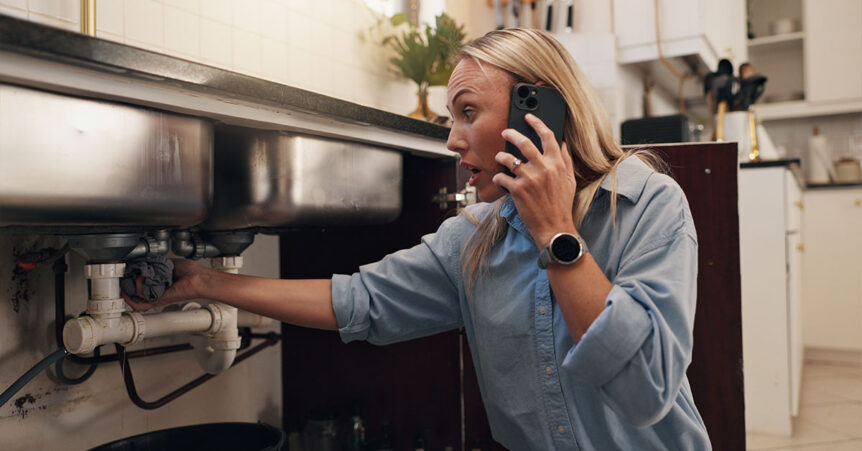- Discover 7 hidden leak sources in your home and learn proven ways to prevent them—protect your plumbing and property before damage strikes.
Introduction
Hidden plumbing leaks can wreak havoc before you even notice them. Across Siouxland—from Sioux City to North Sioux City—yearly freeze-thaw cycles, shifting temperatures, and common wear-and-tear hide many of the leaks that homeowners unknowingly face.
In this in-depth guide, we’ll highlight the 7 sneaky places leaks may be forming in your home, explain why each is a concern, offer preventative tactics, and advise on when it’s time to call a professional plumber. Follow this advice, and you’ll intercept leaks early—saving money, avoiding water damage, and extending the lifespan of your plumbing inside and outside your walls.
1. Behind Walls: Hidden Pinhole Pipe Leaks
🔍 Why It Happens
Small pinhole leaks in copper, PEX, or PVC pipes often start with corrosion, mineral buildup, or pressure fluctuations. Over time, these tiny cracks lead to dripping behind walls, which silently soaks framing and insulation until visible water damage surfaces.
🛠️ Signs to Watch For
- Unexplained water stains or musty odors
- Bubbling or peeling paint on walls
- Damp insulation when inspected
- Mildew, mold, or water staining on drywall
✅ Prevention Tips
- Schedule annual plumbing inspections
- Install pressure regulators to prevent surges
- Monitor water pressure and keep it below 80 psi
- Consider repiping older copper lines
2. Under Sinks: Leaky Shut-Off Valves & Supply Lines
🔍 Why It Happens
The small shut-off valves and flexible supply lines under sinks are crucial but often overlooked. Leaking fittings or corroded braided lines can drip slowly, causing damage before being noticed.
🛠️ Signs to Watch For
- Water pooling in cabinets
- Rotting wood or swollen cabinet bases
- Mold on cabinet walls
✅ Prevention Tips
- Inspect monthly for moisture
- Replace braided lines every 5–7 years
- Tighten fittings gently but firmly
- Consider installing automatic shut-off valves
3. Around Toilets: Faulty Wax Rings & Base Seals
🔍 Why It Happens
The wax ring under your toilet bowl seals it to the drain flange. With age, constant use, or shifting flooring, this seal can fail, letting water seep each flush.
🛠️ Signs to Watch For
- Water pooling near toilet base
- Toilet wobbles or feels loose
- Gurgling sounds in drains or faint sewer odors
✅ Prevention Tips
- Replace wax ring during bathroom updates
- Ensure toilet is anchored securely
- Inspect for wobble and reseat when needed
4. Bathtubs & Showers: Leaky Cartridge, Drain, or Far Casing
🔍 Why It Happens
Leaks from shower valve cartridges, worn seals in drains, or gaps in tile/grout can let water seep into walls and floors.
🛠️ Signs to Watch For
- Grout cracks or missing caulk
- Wet spots or mold on walls or ceilings below
- Unexplained floorwater outside shower area
✅ Prevention Tips
- Replace valve cartridge when leaky
- Re-caulk tub and shower perimeter annually
- Use high-quality mildew-resistant caulk
- Check for loose tiles or cracks in grout
5. Water Heaters: Pressure Relief Valve & Tank Leaks
🔍 Why It Happens
The T&P (temperature and pressure relief) valve may drip if it’s old or tank pressure spikes. Corrosion can form minuscule leaks from the tank itself over time.
🛠️ Signs to Watch For
- Drips from valve discharge pipe
- Water puddles around heater base
- Rust or corrosion on tank exterior
✅ Prevention Tips
- Flush tank yearly to remove sediment
- Inspect T&P valve monthly
- Replace if leaking or older than 5–7 years
- Consider installing a drain pan beneath the unit
6. Outdoor Faucets & Irrigation Connections
🔍 Why It Happens
Backflow valves, hose bibs, and irrigation fittings can freeze and crack in winter—especially if not drained properly. In spring, thawed leaks begin.
🛠️ Signs to Watch For
- Damp ground near hose bibs
- Low outdoor water pressure
- Visible cracks in bib housing
✅ Prevention Tips
- Shut off and drain outdoor faucets before cold weather
- Upgrade to frost-proof hose bibs
- Inspect fittings every spring
7. Hidden Basement or Crawl Space Leaks
🔍 Why It Happens
Water lines, drains, condensate lines, and even sump pits may leak beneath your home. These slow leaks create damp environments that damage subflooring and coatings.
🛠️ Signs to Watch For
- Musty basement smells or visible mold
- Unexplained moisture on walls
- Foundation cracks or efflorescence (white mineral deposits)
✅ Prevention Tips
- Inspect crawl spaces and basement monthly
- Use moisture meters in sweaty crawl spaces
- Ensure proper grading around the home
- Install sump pumps with cover and alarm
Why Acting Early Saves You Money
Hidden leaks don’t stay hidden. Over time, they can:
- Increase water bills
- Cause structural damage and mold
- Require costly drywall, flooring, or insulation repairs
- Cause poor indoor air quality affecting health
- Lead to emergency pipe replacements
Tools & Techniques Plumbers Recommend
| Tool | Use |
|---|---|
| Moisture meter | Detect damp behind walls without opening them |
| Infrared camera | Identify cold spots from leaks within walls |
| Flexible supply line tester | Ensure secure fittings |
| Pressure gauge | Check home water pressure at fixtures |
When to Call A+ Plumbing
If your hidden leak signs include persistent stains, mystery drips, or structural problems, call A+ Plumbing:
- Licensed, Sioux City-based plumbing professionals
- Services for all hidden leak repairs
- Smart solutions to safeguard your home
- Quick-response team serving Siouxland
Conclusion
Hidden plumbing leaks are stealth threats, but you can stay ahead by knowing where they hide and how to prevent them. The 7 sneaky leak sources—from behind walls to frost-prone faucets—are detectable with monthly checks and good maintenance habits.
By combining vigilance with professional plumbing inspections, your home can remain leak-free and secure. To tackle current concerns or preventive maintenance, contact A+ Plumbing today for leak detection and expert repair across Siouxland.

